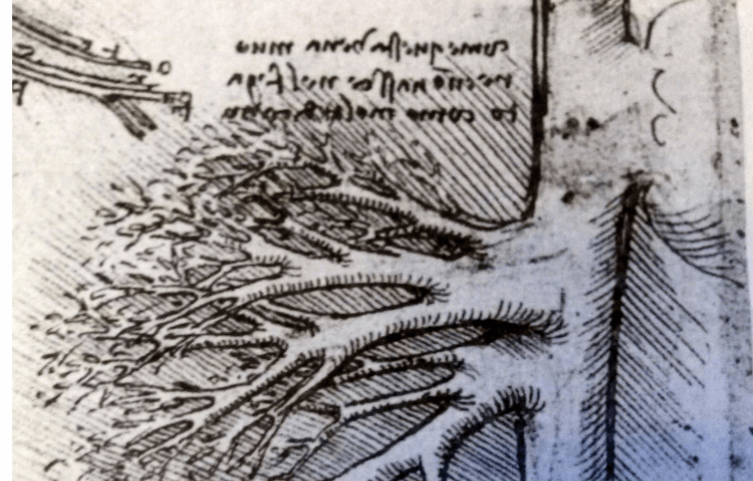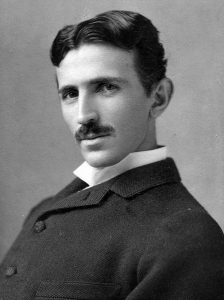In the year 1300, Pope Boniface VIII issued a papal decree, De Sepulturis, which outlawed various methods of lightening the bodies of the diseased for the ease of transport. These methods–common among the Crusaders in the Near East–included the removal of flesh by boiling as well as dismemberment, which also allowed for bodies to be stored in more compact containers. For years after, De Sepulturis was misinterpreted to include the condemnation of anatomical dissection, and for years the study of anatomy would suffer from this misconception. Over time, however, anatomical dissections regained popularity and became important not only to scientists of the body, but also to artists like Michelangelo and Leonardo Da Vinci. However, even into the 1500’s, anatomical sketches were considered distractions unworthy of publication in anatomy textbooks.1

Leonardo Da Vinci, the famous Italian polymath most commonly known today for his painting Mona Lisa, was not renowned for his anatomical diagrams in his time; but unlike his artist peers, his illustrations of the human structure went far beyond the superficial arteries and musculature. While his diagrams do not indicate formal training or even first-hand experience at dissection, Da Vinci began sketching the human anatomy at four different perspectives, simulating a three-dimensional model. Furthermore, Da Vinci sketched the bodily organs, and even wrote about their anatomical functions. It seems that it was Da Vinci’s unquenchable thirst for knowledge and inquiry that drove him to observe deeper than what most deemed necessary. This was characteristic of Leonardo from a young age. Indeed, in 1478, when Leonardo began his career in Florence under the Compagnia de San Luca, he was just sixteen. His early loves for mathematics and mechanics were maintained throughout his life and consistently influenced his vision of the world.4;

Vision was a key aspect to human knowledge to Da Vinci. Being a man of many talents and interests, Da Vinci was drawn to many occupations, and in 1478, after recommending himself to the Duke of Milan, he was made a royal appointee to the duke, Lodovico Sforza, as chief military engineer. In his letter of self-recommendation, Da Vinci referred to himself not only as an artist, but also as a mathematician, architect, and engineer. One of Da Vinci’s first tasks in Milan was to supervise the construction of the Cathedral at Pavia, which would become one of the largest cathedrals in the world. However, it is reported that Da Vinci became so immersed in the theoretical aspects of the physical laws and mechanics involved in the construction of the cathedral that his subordinate had to assume leadership on the practical matters of construction. During this time, Da Vinci also began a practice that has allowed historians and enthusiasts to obtain much deeper insight into the course of Da Vinci’s intellectual studies; like many intellectuals of the Renaissance, Da Vinci began cataloging and recording his studies in notebooks. Many of the anatomical sketches that still survive today were contained in such notebooks. Regardless of his official position as chief military engineer, however, Da Vinci’s primary modes of creation were artistic. Indeed, it was in Milan that Da Vinci finished the paintings Madonna of the Rocks, and The Last Supper; both are masterpieces of human expression and artistic style and technique.5
In 1500, Da Vinci left Milan and continued to paint. He spent several years as a vagabond and finished few paintings during these years, although the famous Mona Lisa was among those left unfinished around the year 1503. At the age of sixty-three, he was appointed to the company of the king of France, near Ambroise, where his chief duty was to keep good company to the king. Leonardo spent the last ten years of his life continuing his research in the realm of the physical sciences, and died on May 2, 1519.6
- Leonardo da Vinci, Leonardo Da Vinci on the Human Body: The Anatomical, Physiological, and Embryological Drawings of Leonardo Da Vinci, eds. Charles Donald O’Malley and John Bertrand de Cusance Morant Saunders (New York: H. Schuman, 1952), 13. ↵
- Leonardo da Vinci, Leonardo Da Vinci on the Human Body: The Anatomical, Physiological, and Embryological Drawings of Leonardo Da Vinci, eds. Charles Donald O’Malley and John Bertrand de Cusance Morant Saunders (New York: H. Schuman, 1952), 131. ↵
- Leonardo da Vinci, Leonardo Da Vinci on the Human Body: The Anatomical, Physiological, and Embryological Drawings of Leonardo Da Vinci, eds. Charles Donald O’Malley and John Bertrand de Cusance Morant Saunders (New York: H. Schuman, 1952), 14-16. ↵
- Leonardo da Vinci, Leonardo Da Vinci on the Human Body: The Anatomical, Physiological, and Embryological Drawings of Leonardo Da Vinci, eds. Charles Donald O’Malley and John Bertrand de Cusance Morant Saunders (New York: H. Schuman, 1952), 14-19 ↵
- Leonardo da Vinci, Leonardo Da Vinci on the Human Body: The Anatomical, Physiological, and Embryological Drawings of Leonardo Da Vinci, eds. Charles Donald O’Malley and John Bertrand de Cusance Morant Saunders (New York: H. Schuman, 1952), 18-21; Toby Lester, Da Vinci’s Ghost : Genius, Obsession, and How Leonardo Created the World in His Own Image (New York : Free Press, 2012), 117-121; Salem Press Biographical Encyclopedia, 2016, s.v. “Leonardo Da Vinci,” by James Livingston. ↵
- Salem Press Biographical Encyclopedia, 2016, s.v. “Leonardo Da Vinci,” by James Livingston. ↵



90 comments
Joshua Castro
This article was extremely informative and fascinating! I had always thought of Da Vinci as an astounding mathematician, artist, and inventor, but was never aware that he had such a deep thirst of knowledge for human anatomy and to apply it into his artwork! In my books, Da Vinci was one of the most fascinating men in history and I am almost always surprised to find out that there was something new to learn about him!
Belia Camarena
This article was really interesting to read! I had always known Leonardo Da Vinci to be an artist and an intellect, but I never knew that he worked with the human body and created sketches for scientists. Da Vinci was truly a renaissance man, and it is awesome that he felt compelled to learn as much as possible, even if it wasn’t considered part of his field.
Caroline Bush
Interesting article! Before reading this article I only ever thought of Da Vinci as a artist and architect. I thought that this article was intresting beacuse it shed some new light on other aspects of Da Vinci inrests byound painting. I also liked this article because I never concidered how people disposed of bodies in the past. I also enjoyed the pictures featured in this article and felt that they added and extra layer to the topic. Overall i really enjoed this article and found the topic very intresting.
Jasmine Jaramillo
I’ve always known that Leonardo Da Vinci was a talented man but I never knew that he also worked with the human body and provided sketches for scientists. It’s pretty cool to read that he liked to be well-rounded and tried to be knowledgeable in many subjects. The fact that he actually to the time to gain experience in all his fields speaks immensely of Da Vinci. This article was well written and very interesting.
Iris Henderson
I have never really taken the time to think about how the removal of diseased bodies was handled historically. It is pretty disturbing, actually. However, it was interesting to learn about Da Vinci’s interest and work with human anatomy. I liked that Da Vinci referred to himself not only as an artist but as a mathematician, engineer, and architect. His work certainly proves his interest and devotion to all of these realms.
Samuel Stallcup
I feel most people only know Da Vinci for Mona Lisa and the Vitruvian Man, and are not aware that da Vinci was quite the scientist. This article showcases that Da Vinci was more than just an artist and architect. It’s amazing how he was able to use his talents to expose new things we did not know about the human body.
Jason Garcia
I just learned about dissections and autopsy being taboo in the early years of man. Spiritual beliefs lead to this but thanks to people like Da Vinci and Michelangelo we have a deep understanding of the human anatomy. which allows surgeons and doctors to help people live long and healthy lives. I’m sure at the time they were cast out of society for performing such vile deeds but the world would come to know these people as heroes and founders of modern medicine.
Bryan Martin Patino
It was an interesting thing to read about from what i know about the time and da vinci I heard that he would collect the dead corpses and find learn about the human biology. but it is still great knowing that he took learning into his own hands when text books where not a reliable source.
Arianna Kennet
An interesting and informative read. I had not known that Da Vinci had taken interest in the human anatomy and the functions of different organs, or that he was also an architect and engineer, besides being a mathematician. A man of many talents I must say. Da Vinci was a very intellectual man and it really shows in his work and how he pursued learning and going deeper into topics or subjects that interested him.
Natalia Flores
This article was incredible! This created a deeper insight into what else Da Vinci did during his lifetime. The misinterpretation of the Papal decree of 1300 hindered the amount of study people could do through dissection. This in turn slowed down anatomical studies, but it’s amazing how it didn’t stop Da Vinci from looking into it through apothecaries. I did not know that the drawings of the human body were not wanted in anatomy books which concerns me. How did they know what they were cutting? Or where to cut? Or what it even looked like?